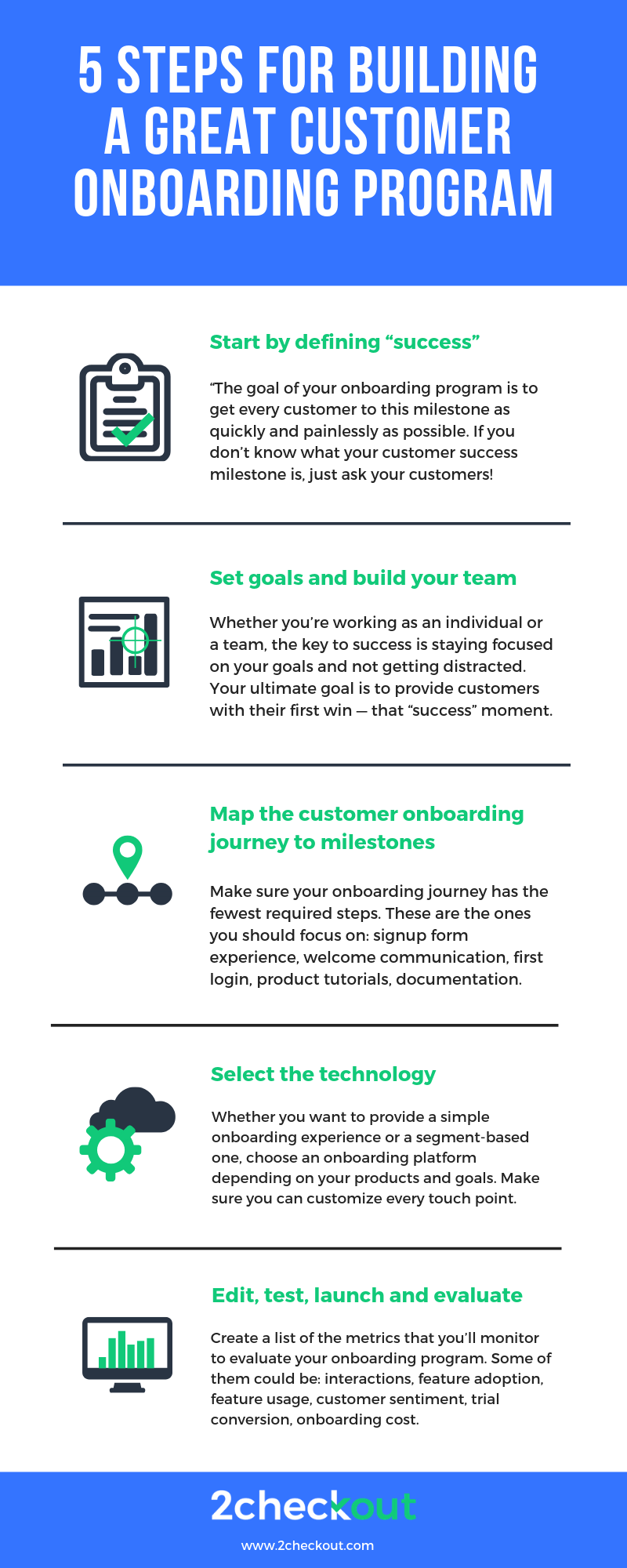Imagine you just signed up (and paid!) for a new SaaS product—accounting software, perhaps. You get an email with your login information, but not much more on how to get started. You log in and click around a bit, but there’s no product walkthrough and you’re confused about what to do next. You don’t want to manually enter your existing information (what a chore!)—you want to import it from another tool. The product promised it could do that, but you can’t quite figure out how it works. You go through the help documentation, but can’t figure out the integration with your previous software. After customer support keeps you on hold for 10 minutes, you get frustrated and cancel your subscription. You’ll just stick with what you already have.
Sound familiar? A well-designed customer onboarding program can prevent this type of instant churn by helping new customers become successful with a product quickly. If you’re reading this, you know that customer onboarding is more than just getting your customers to log in to your product. If that were all it took, everyone would be an onboarding expert! Onboarding is about helping customers succeed with your product quickly, and getting them to come back for more. But how do you get customers to that success point? This post provides a checklist to help you build a customer onboarding program that will empower your customers to achieve success, and keep them around.
Step 1. Start by defining “success”
We can agree that customers have been onboarded once they’ve achieved success with your product. The hard part is defining what this initial “success” with your product looks like. Whether it’s reaching a specific touch point in the product journey, such as uploading a new image, making the first sale, publishing the first post, or simply seeing the value of the product itself (rather than your sales and marketing promises about it), this milestone is what will define success for your program. The goal of your onboarding program is to get every customer to this milestone as quickly and painlessly as possible. The good news is, it doesn’t have to be complicated. The bad news is, it does have to be specific. Like I said, “logging in” is not enough.
If you don’t know what your customer success milestone is, just ask! Survey your existing happy customers to find out how they define success with your product. Because different groups of customers have different needs, it can be helpful to break customers into cohorts for this analysis. The success metric for small businesses may be different from that for enterprise organizations, for example.
If your customer cohorts aren’t yet very clear, focus primarily on your ideal customer—the one you’re most directly going after. Ask these customers about their desired outcome (a combination of an outcome and the experience of getting to it) for your product, how they measure their own success, how their bosses measure success and what they want to achieve with your product. This information will help you pinpoint the “aha” moment that defines success.
Step 2. Set goals and build your team
Once you’ve defined the “success” your customer onboarding team will work toward, you can begin actually building your program. Just as you need to define “success” in order to know when a customer has been onboarded, you have to define goals to measure your onboarding team’s success. Some basic goals for a customer onboarding team might also include:
- Training customers to use your product.
- Instilling customers with a sense of confidence in working with your company.
- Providing customers with their first win—that “success” moment.
There are many roles that can be helpful in a customer success team, but the three most important roles to start with are:
- Subject matter expert (SME) who’s well versed in the onboarding topics you wish to cover in your program, as well as the product itself.
- UX designer who’ll interview and work with the SME(s) to design content and organize information so it’s easy for your customers to consume and understand.
- Product Manager who oversees the entire project, ensuring that the project plan is followed according to deadlines, milestones, and budget.
If you’re part of a smaller company or are early in your onboarding initiative, you and your colleagues may have to take on multiple roles, but don’t worry—you can still be successful. Whether you’re working as an individual or a team, the key to success is staying focused on your goals and not getting distracted by other factors.
Step 3. Map the customer onboarding journey to milestones
As a customer onboarding team, you’re working to get your customers to a specific “aha” moment that indicates they’ve been onboarded and are achieving success with your product. As you might guess, this moment doesn’t just randomly happen: there are a lot of specific steps and interactions required to help customers reach success. Since you want to achieve a successful outcome as fast as possible, define your “minimum path to awesome”—the customer onboarding journey with the fewest required steps.
If you’re not sure what’s on your path to awesome, check out some steps that are typically included in an onboarding journey. The main question to ask is: what can you do at each touch point to prepare customers for success later in their journey? A few key onboarding steps include:
- Signup Form Experience. Signing up should be intuitive and remove barriers, such as asking for too much information. Consider asking a few pre-qualifying questions to help you personalize the rest of the onboarding experience.
- Welcome Communication. It may be tempting to pack your first email to customers with a lot of information, but it pays to use restraint. Focus on simple next steps and make it clear where customers can turn if they need help.
- First Login. Make account setup as effortless as possible. If you really need a piece of information, ask for it. If it’s not essential to the core experience, let customers know it’s optional and then remind them to provide it later. A well-designed product will only require the information needed for each task.
- Product Tutorials. Showing what the product can do is a critical step in the customer onboarding process. Fortunately, there are many ways to do this:
- Create a series of step-by-step training videos.
- Create a video product tour.
- Embed training modules throughout your product.
- An educational email communication series.
No matter what training method you choose, make sure it’s short and interactive, and let your customers do the “driving,” so to speak.
- Documentation must be easy for users to find and understand.
Step 4: Select the technology
There are many different customer onboarding platforms available. The one you choose will depend on the nature of your products and services, as well as your onboarding program goals. Whether you want to provide high-touch onboarding handled by humans, high-tech onboarding driven by the product or segment-based onboarding that’s easy to customize for different audiences, there’s definitely a customer onboarding platform available for you. Try a few and choose the one that best meets your needs.
Step 5: Edit, test, launch and evaluate
Whew! You’ve done a lot of work already, but we’re not quite done. I promise, though, it’ll all be worth it in the end! Once you have your onboarding goals, team, journey, and technology all nailed down, it’s time to create a list of the metrics that you’ll monitor to evaluate your onboarding program. These metrics might include, but aren’t limited to:
- Interactions: logins, support tickets, and page visits are all interactions.
- Feature adoption: how many features customers use successfully, on average.
- Feature usage: how often customers use certain features. Tip: Consider eliminating rarely-used features, unless specific customer groups care about them.
- Customer sentiment: measure this with onboarding-specific surveys.
- Trial conversion: the percentage of users who upgrade to a paid product or service by the end of their trial period.
- Onboarding cost: keep this reasonably low, but invest in your customers.
Once these metrics are defined, it’s time to make your final edits, test everything out and launch your new customer onboarding program! It may be a good idea to launch with a small segment of customers to refine your processes before going bigger.
Customer onboarding may seem complicated, but we hope this guide breaks down the steps you need to get started. Give it a try and tell us how it goes for you!






